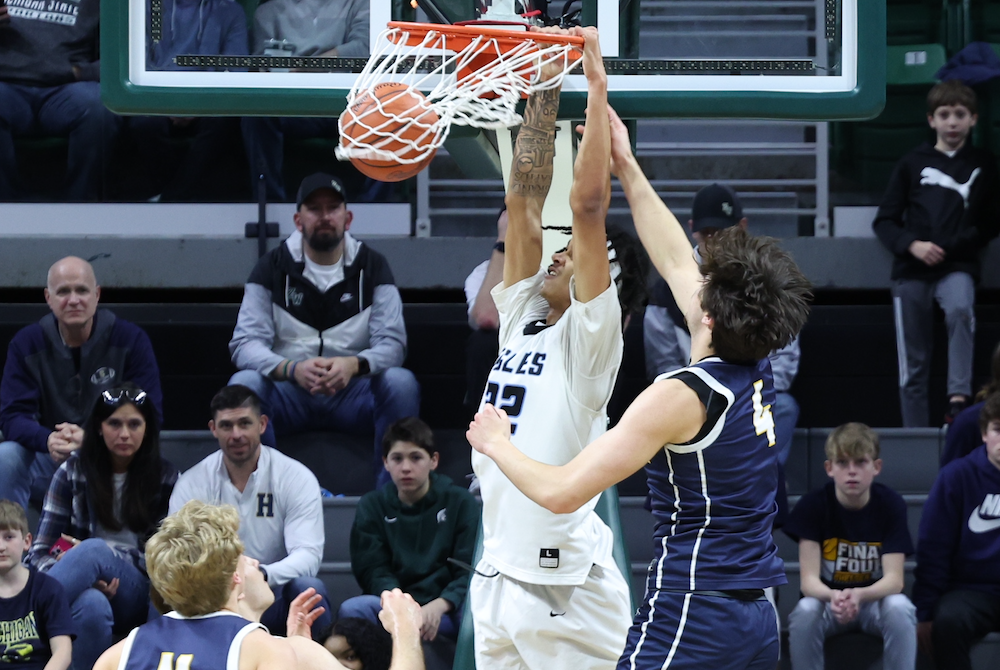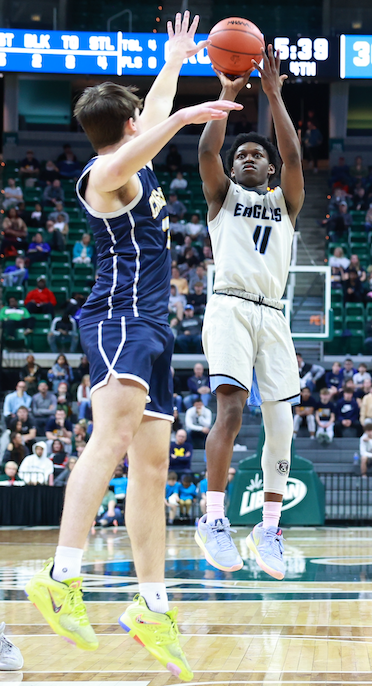
MHSA(Q&)A: Historian Ron Pesch
April 16, 2012
 When we receive a question on the history of MHSAA athletics that we can't answer on the spot, Muskegon's Ron Pesch is the first person we seek out for help.
When we receive a question on the history of MHSAA athletics that we can't answer on the spot, Muskegon's Ron Pesch is the first person we seek out for help.
Pesch took the reins as Michigan's chief high school sports historian during the mid 1990s after the retirement of legendary MHSAA record book originator Dick Kishpaugh and has contributed to various efforts and publications across the state.
One of his latest projects is the awarding of "retro" Mr. Basketball Awards. The first Hal Schram Mr. Basketball Award was given by the Basketball Coaches Association of Michigan in 1981 to Lansing Eastern's Sam Vincent. Three seasons ago, BCAM -- with research work by Pesch -- began awarding retro winners for the previous decades beginning with the 1920s. This winter, BCAM honored retro winners from 1922, 1932, 1942, 1952, 1962 and 1972.
Click to read more about those winners and the finalists recognized last month. Also, click for links to the previous retro winners. The retro Mr. Basketball project will last seven more seasons. Pesch explains more below.
How did you come up with rewarding a “Retro” Mr. Basketball?
The project came out of a conversation I had with (BCAM executive director) Tom Hursey at the basketball finals back in '99. Together, we hatched an approach honoring the state's past basketball greats. He let me run with it, while he worked on getting a subcommittee launched to make the selection.
How do you dig up all of this nomination info?
Between votes, I work on digging out the details. My initial target list always begins with all-state teams - if, of course they exist. All-tournament teams for the early years also serve as a starting point -- if they exist. Best I can tell, the Detroit Times, the Free Press and the News have all named all-state squads, at various points, back to about 1935. The Associated Press and UPI came to the game much later - somewhere around the early to mid 1960s. I then work on creating a crosstab on the players selected, noting the "teams" on which they were named (Class A 1st team, Dream Team, Class C 3rd team), and try to find quotes detailing their games. The result is really a reflection of the times and the history of newspaper reporting.
In early years, we can struggle to uncover a player’s first name, let alone his class in school. And statistical coverage of a player's abilities was very limited. It's simply the way things were back then. Everyone in town knew King Lewis, or Red Cherry, or Young Jacks. And the final box score only contained points, fouls, substitutions, as they were all you really needed to know about the game. But by visiting the state library in Lansing, and looking at a cross-section of newspapers, you can usually dig out what you need.
Do you collect from other sources as well?
Another source is high school yearbooks. Some resources have started to emerge online. I also tap into the MHSAA site and make contact with ADs around the state, asking for their assistance on digging out details - especially class in school. Like the current program, only "seniors" are considered for the award. Mid-year graduates can create a challenge, but the rule currently in place is a player is considered a nominee in the year in which he was last eligible for the state tournament. In other words, if you graduated in January or February of 1943, you would be considered for the 1942 ballot. It appears that a similar approach was used in selecting all-state teams.
|
Year |
Player |
High School |
Age |
Height |
Weight |
Year |
DFP |
DN |
DT |
AP |
UPI |
Tourney |
|
1971 A-1 G. |
Frank Tanana, Jr. (C) |
Detroit Catholic Central |
17 |
6-3 |
170 |
Sr. |
A1 |
A1 |
A1 |
A1 |
||
|
1971 A-1 C |
Tom McGill |
Flint Northern |
17 |
6-3 |
190 |
Sr. |
A1 |
DM |
A1 |
A1 |
||
|
1971 A-1 F. |
Lindsay Hairston |
Detroit Kettering |
17 |
6-9 |
203 |
Sr. |
A1 |
DM |
A1 |
A1 |
||
|
1971 A-1 F. |
Campy Russell |
Pontiac Central |
18 |
6-7 |
190 |
Sr. |
A1 |
DM |
A1 |
A1 |
That cross-tab table will help establish a list of nominees. A consensus first-team pick is an obvious candidate. When only a single all-state team is available, I'll do what I can to look up all-conference teams or all-area teams from around the state to see who else might be considered. While life after high school is not a considered when trying to pick a winner, a player who emerges as a star in college or in the pros may emerge as a candidate when you see his details in a local paper.
Bios are assembled from the newspaper reports, detailing as much as we can find on high school player's career. I'll tap into a variety of resources including old team histories when available. When needed, I'll toss out request to reporters, old and new, around the state. Local librarians and historians are another wonderful resource.
How does voting work?
Between sessions of the Boys Finals, the committee assembles to hash out a final ballot, and to make a selection. I don't vote, but I may guide the conversation and provide any additional details when needed, reminding members that we're focusing on their high school careers. The process is certainly imperfect. But the committee approach prevents the process from becoming a popularity contest. These guys have the benefit of watching many of the players play. And, like the current Mr. Basketball program, they sometimes surprise. But that's what makes it fun. And, of course, stirs the pot. It gets people talking about the history of basketball in this state.
Is there a theme to MHSAA basketball that has remained constant over the years?
For me the greatest thing about the basketball tournament is that it assembles a wide range of folks who want to see players they've heard about in action. And the process, for the most part, hasn't change since the 1920s. While the style of the game has changed, winning a title is much the same as it was back when our great-grandfathers played: You gotta get through the tournament. And only four trophies are awarded.
These guys were the "Magic" of their day. I'm hoping we never forget that.

GR Christian Withstands Late Chelsea Rally to Book Historic Opportunity
By
Steve Vedder
Special for MHSAA.com
March 15, 2024
EAST LANSING – Grand Rapids Christian has never looked at it as courting disaster.
The Eagles admit there have been a handful of games where major trouble has been averted by a strong second half. The latest example was Friday's tight 50-41 win over Chelsea in a Division 2 Semifinal at the Breslin Center.
Instead of fretting about slow starts, the Eagles say they prefer to dwell on what happens during the final two crucial quarters. In the win over Chelsea, for example, the Eagles nearly let a 10-point lead slide away over the final five and a half minutes before hitting some clutch free throws and limiting the Bulldogs to just three points during the final 4:25.
Business as usual, said the Eagles (25-2), who will play Warren Lincoln in Saturday's 6:45 p.m. Final. It’s a matchup of the top two-ranked teams in Division 2 and a rematch of a 49-47 Warren Lincoln win earlier in the season. Grand Rapids Christian will be playing for a first championship since winning the Lower Peninsula Class B title in 1938.
"We get a little excited early sometimes," Eagles senior Jaylan Ouwinga said. "Maybe we move too fast or too slow, but we forget slow starts and just get the job done. We work on coming out strong, but we've had to learn to just let the game come to us."
 Such was the case against Chelsea (21-6). Grand Rapids Christian led 40-30 with 5:34 left, but an 8-0 Bulldogs run cut the margin to 40-38 with 4:25 to go. Ouwinga made a basket, Carter Goodyke added a layup and the Eagles managed seven free throws down the stretch to seal the win.
Such was the case against Chelsea (21-6). Grand Rapids Christian led 40-30 with 5:34 left, but an 8-0 Bulldogs run cut the margin to 40-38 with 4:25 to go. Ouwinga made a basket, Carter Goodyke added a layup and the Eagles managed seven free throws down the stretch to seal the win.
Grand Rapids Christian's Tyler Davis said the team is aware of the dangers of slow starts.
"We talk about it, and we know it's not so great," he said. "We've never been here before, but we have confidence. We're not going to get down on each other because of someone's mistake."
Eagles coach Eric Taylor said the key to stronger second halves isn't complicated.
"Guys are focused," he said. "We've never wavered. They made some runs at us and cut the lead. We talked about basketball being a game of runs. We didn't lose focus because another team makes a run, because it happens."
Ouwinga had 13 points and 13 rebounds. Senior guard Nate Johnson added 13 points, and Davis had 10.
Johnson said second-half strength is something the team has capitalized on all season.
"It's something we've acquired," he said. "We stay resilient and keep our heads in the game. We stay strong mentally and stick to the game plan."
Jake Stephens had 18 points and 10 rebounds for Chelsea.
Taylor said experience has been a factor in the team's success. There are nine seniors on the roster, and they benefitted from a schedule that included seven ranked teams.
"We're very battle-tested," Taylor said. "We've proven we're ready for the moment; we know we have to play 32 minutes, not 28. (Slow starts) aren't what we like, but tough players win and we've been tough all year."
Chelsea coach Andrea Cabana said there were chances to win.
"They made enough runs in the second half that we allowed them to get away from us," she said. "We've played a tough schedule; teams similar to who they've played. We're gritty and never give up. We got a couple turnovers late, but couldn't capitalize on them. We were relentless, which is how we play."
PHOTOS (Top) Grand Rapids Christian’s DeClan Winstanley (22) dunks before Chelsea’s Hayden Long (4) can get a hand in to stop the attempt. (Middle) Tyler Davis (11) launches a jumper from the top of the key during the Eagles’ Division 2 Semifinal win. (Photos by Hockey Weekly Action Photos.)

